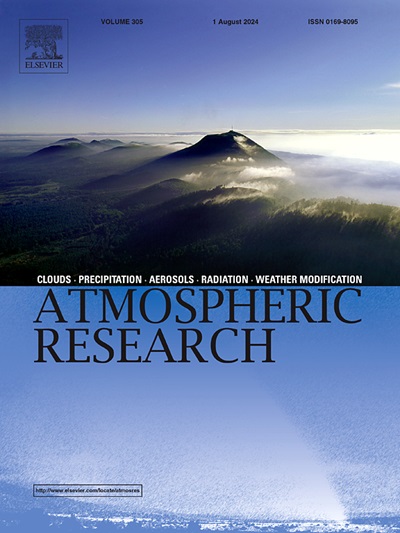Changes of atmospheric warming associated with rapid sea ice loss events on the synoptic time scale in winter
IF 4.5
2区 地球科学
Q1 METEOROLOGY & ATMOSPHERIC SCIENCES
引用次数: 0
Abstract
This study examines how the Arctic warming during rapid sea ice decline changes over Barents-Kara Seas (BKS) on the synoptic time scale in winter. We divide the satellite record 1979–2024 into two time periods: 1979–2002 (P1) and 2003–2024 (P2), with a focus on the difference between P1 and P2. A rapid sea ice loss event is defined, when the sea ice tendency index falls below the 5th percentile of the corresponding P1/P2 time series for at least three consecutive days. Composite analysis shows that the negative center of sea ice concentration anomaly for rapid sea ice loss events in P2 shifts more northward compared to P1, consistent with the retreat of Arctic sea ice edge due to global warming. Climate change influences the position and structure of atmospheric anticyclonic anomaly over BKS associated with rapid sea ice loss, which makes the maximum adiabatic cooling in the upper troposphere shift to mid-troposphere and enhances the horizontal temperature advection, particularly in the meridional direction near the surface. Consequently, the positive atmospheric temperature anomaly intensifies, with the maximum at 800 hPa shift to the surface, despite enhanced diabatic cooling in the lower troposphere over BKS. This study underscores the significance of enhanced warm horizontal temperature advection with bottom amplified on the surface warming during rapid sea ice decline in the recent decades. As a result, the positive skin temperature anomaly is also magnified, which is due to increased downward longwave radiation resulting from increased atmospheric temperature and moisture over BKS.
冬季天气时间尺度上与海冰快速消融事件相关的大气变暖变化
本文研究了巴伦支-喀拉海(BKS)海冰快速下降期间北极变暖在冬季天气时间尺度上的变化。我们将1979-2024年的卫星记录分为两个时间段:1979-2002年(P1)和2003-2024年(P2),重点分析了P1和P2的差异。当海冰趋势指数连续至少三天低于对应的P1/P2时间序列的第5个百分位数时,定义为快速海冰损失事件。综合分析表明,P2海冰快速损失事件的海冰浓度异常负中心比P1更北移,与全球变暖导致的北极海冰边缘退缩一致。气候变化影响了BKS上空大气反气旋异常的位置和结构,使得对流层上层的最大绝热冷却向对流层中层转移,并增强了水平温度平流,特别是在近地面的经向方向。因此,尽管BKS上空对流层下层的非绝热冷却增强,但大气温度正异常增强,在800 hPa处的最大值转移到地面。本研究强调了近几十年来海冰快速减少过程中,暖水平温度平流的增强和底部的放大对地表变暖的重要性。因此,正的皮肤温度异常也被放大,这是由于BKS上空的大气温度和湿度增加导致向下的长波辐射增加。
本文章由计算机程序翻译,如有差异,请以英文原文为准。
求助全文
约1分钟内获得全文
求助全文
来源期刊

Atmospheric Research
地学-气象与大气科学
CiteScore
9.40
自引率
10.90%
发文量
460
审稿时长
47 days
期刊介绍:
The journal publishes scientific papers (research papers, review articles, letters and notes) dealing with the part of the atmosphere where meteorological events occur. Attention is given to all processes extending from the earth surface to the tropopause, but special emphasis continues to be devoted to the physics of clouds, mesoscale meteorology and air pollution, i.e. atmospheric aerosols; microphysical processes; cloud dynamics and thermodynamics; numerical simulation, climatology, climate change and weather modification.
 求助内容:
求助内容: 应助结果提醒方式:
应助结果提醒方式:


